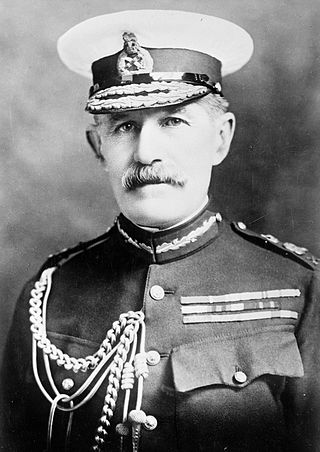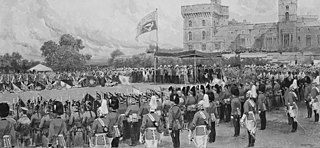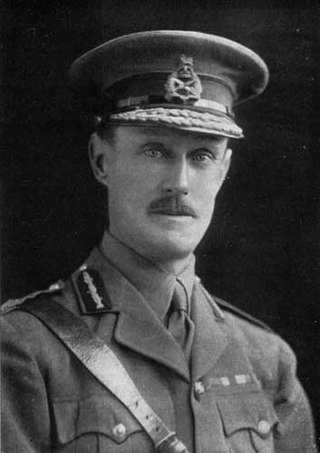The British Expeditionary Force (BEF) was the six divisions the British Army sent to the Western Front during the First World War. Planning for a British Expeditionary Force began with the 1906–1912 Haldane Reforms of the British Army carried out by the Secretary of State for War Richard Haldane following the Second Boer War (1899–1902).

Field Marshal John Denton Pinkstone French, 1st Earl of Ypres,, known as Sir John French from 1901 to 1916, and as The Viscount French between 1916 and 1922, was a senior British Army officer. Born in Kent, he saw brief service as a midshipman in the Royal Navy, before becoming a cavalry officer. He achieved rapid promotion and distinguished himself on the Gordon Relief Expedition. He became a national hero during the Second Boer War. During the Edwardian period he commanded I Corps at Aldershot, then served as Inspector-General of the Army, before becoming Chief of the Imperial General Staff in 1912. He helped to prepare the British Army for a possible European war, and was among those who insisted that cavalry still be trained to charge with sabre and lance. During the Curragh incident he had to resign as CIGS after promising Hubert Gough in writing that the Army would not be used to coerce Ulster Protestants into a Home Rule Ireland.

General Sir Ian Standish Monteith Hamilton, was a senior British Army officer who had an extensive British Imperial military career in the Victorian and Edwardian eras. Hamilton was twice recommended for the Victoria Cross, but on the first occasion was considered too young, and on the second too senior. He was wounded in action at the Battle of Majuba during the First Boer War, which rendered his left hand permanently injured. Near the end of his career, he commanded the Mediterranean Expeditionary Force in the Gallipoli Campaign of the First World War.
The Mediterranean Expeditionary Force (MEF) was the part of the British Army during World War I that commanded all Allied forces at Gallipoli and Salonika. It was formed in March 1915, under the command of General Sir Ian Hamilton, at the beginning of the Gallipoli campaign of the First World War.

General Sir Horace Lockwood Smith-Dorrien, was a British Army General. One of the few British survivors of the Battle of Isandlwana as a young officer, he also distinguished himself in the Second Boer War.

The Territorial Force was a part-time volunteer component of the British Army, created in 1908 to augment British land forces without resorting to conscription. The new organisation consolidated the 19th-century Volunteer Force and yeomanry into a unified auxiliary, commanded by the War Office and administered by local county territorial associations. The Territorial Force was designed to reinforce the regular army in expeditionary operations abroad, but because of political opposition it was assigned to home defence. Members were liable for service anywhere in the UK and could not be compelled to serve overseas. In the first two months of the First World War, territorials volunteered for foreign service in significant numbers, allowing territorial units to be deployed abroad. They saw their first action on the Western Front during the initial German offensive of 1914, and the force filled the gap between the near destruction of the regular army that year and the arrival of the New Army in 1915. Territorial units were deployed to Gallipoli in 1915 and, following the failure of that campaign, provided the bulk of the British contribution to allied forces in the Sinai and Palestine Campaign. By the war's end, the Territorial Force had fielded twenty-three infantry divisions and two mounted divisions on foreign soil. It was demobilised after the war and reconstituted in 1921 as the Territorial Army.

IV Corps was a corps-sized formation of the British Army, formed in both the First World War and the Second World War. During the First World War the corps served on the Western Front throughout its existence. During the Second World War it served in Norway and Britain until it was transferred to India, which was threatened with attack after Japan entered the war.

Field Marshal William Edmund Ironside, 1st Baron Ironside, was a senior officer of the British Army who served as Chief of the Imperial General Staff during the first year of the Second World War.

The II Corps was an army corps of the British Army formed in both the First World War and the Second World War. There had also been a short-lived II Corps during the Waterloo Campaign.

The Reserve Army was a field army of the British Army and part of the British Expeditionary Force during the First World War. On 1 April 1916, Lieutenant-General Sir Hubert Gough was moved from the command of I Corps and took over the Reserve Corps, which in June before the Battle of the Somme, was expanded and renamed Reserve Army. The army fought on the northern flank of the Fourth Army during the battle and became the Fifth Army on 30 October.

The Allies, or the Entente, were an international military coalition of countries led by France, the United Kingdom, Russia, the United States, Italy, and Japan against the Central Powers of Germany, Austria-Hungary, the Ottoman Empire, and Bulgaria in World War I (1914–1918).

General Sir Archibald James Murray, was a British Army officer who served in the Second Boer War and the First World War. He was chief of staff to the British Expeditionary Force (BEF) in August 1914 but appears to have suffered a physical breakdown in the retreat from Mons, and was required to step down from that position in January 1915. After serving as Deputy Chief of the Imperial General Staff for much of 1915, he was briefly Chief of the Imperial General Staff from September to December 1915. He was subsequently Commander-in-Chief of the Egyptian Expeditionary Force from January 1916 to June 1917, in which role he laid the military foundation for the defeat and destruction of the Ottoman Empire in the Arabian Peninsula and the Levant.

General Sir Alexander John Godley, was a senior British Army officer. He is best known for his role as commander of the New Zealand Expeditionary Force and II Anzac Corps during the First World War.

Lieutenant General Sir Hugh Jamieson Elles was a British officer and the first commander of the newly formed Tank Corps during the First World War.

Lieutenant-General Sir Thomas D’Oyly Snow, was a British Army officer who fought on the Western Front during the First World War. He played an important role in the war, leading the 4th Division in the retreat of August 1914, and commanding VII Corps at the unsuccessful diversion of the Attack on the Gommecourt Salient on the first day on the Somme and at the Battle of Cambrai in November 1917.

The Allied leaders of World War I were the political and military figures that fought for or supported the Allied Powers during World War I.

Lieutenant General Sir Vernon Ashton Hobart Sturdee, was an Australian Army commander who served two terms as Chief of the General Staff. A regular officer of the Royal Australian Engineers who joined the Militia in 1908, he was one of the original Anzacs during the First World War, participating in the landing at Gallipoli on 25 April 1915. In the campaign that followed, he commanded the 5th Field Company, before going on to lead the 8th Field Company and the 4th Pioneer Battalion on the Western Front. In 1918 he was seconded to General Headquarters (GHQ) British Expeditionary Force as a staff officer.

Aldershot Command was a Home Command of the British Army.

General Officers of World War I is an oil painting by John Singer Sargent, completed in 1922. It was commissioned by South African financier Sir Abraham Bailey, 1st Baronet to commemorate the generals who commanded British and British Empire armies in the First World War.
Third Army was a home service formation of the British Army during the First World War.















